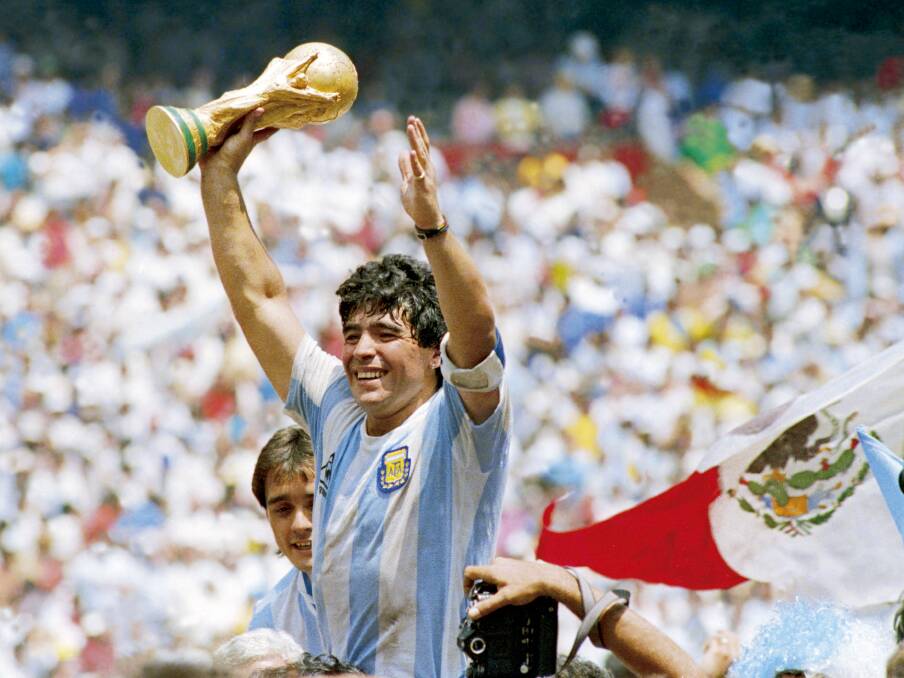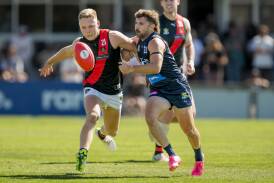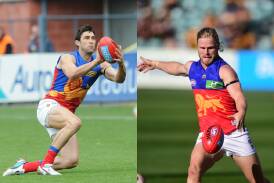
Once asked to name his starting 11 in 1990, Argentina manager Carlos Bilardo replied: "Maradona and 10 others."
Subscribe now for unlimited access.
$0/
(min cost $0)
or signup to continue reading
In a team game, Diego Maradona was the ultimate individual.
A generation after Pele inspired Brazil to global domination and became synonymous with the no.10, Maradona did the same for their South American neighbours.
The two still stand clear of all others in any debate about the greatest ever, despite the best efforts of pretenders like Cruyff, Platini, Beckenbauer, Ronaldo, the other Ronaldo and the heir to Maradona's Argentine throne, Messi.
As an Englishman, it should be in my DNA to despise Maradona - who died of a heart attack, aged 60, last Wednesday - because of the events of June 22, 1986, which defined the individual and divided public opinion.
In the match which would come to embody his flawed genius status, Maradona displayed the extremes of his split personality in the space of just four minutes.
His two major contributions on that scorching afternoon in front of 114,580 fans at Mexico's Estadio Azteca would both earn their own name, wikipedia page and eternal infamy.
The self-titled "Hand of God goal" would see the 26-year-old branded a cheat by supporters of England, whereas the "Goal of the Century" would see him adored by the rest of the world's.
Coming four years after the two nations had fought over the Falkland Islands, those four minutes demonstrated how explosively sport and politics can mix.
On a lumpy, re-laid pitch hardly conducive to silky control, Maradona dribbled past bewildered defenders Peter Beardsley, Peter Reid, Terry Butcher, Terry Fenwick, Butcher (again) and finally goalkeeper Peter Shilton, who was still fuming over the unseen handball moments earlier.
Striker Gary Lineker - who scored England's consolation and so nearly an equaliser - said it was the closest he ever came to applauding an opposition goal.
A week later, Maradona would set up the winning goal as Argentina beat West Germany in the same stadium.
Pictures of the no.10 holding aloft the Jules Rimet trophy after orchestrating a European defeat at the Azteca were uncannily reminiscent of his Brazilian counterpart 16 years and eight days earlier.
Indeed the career of Maradona - the boy from the Buenos Aires slums who made his international debut at just 16 - was immortalised in a handful of iconic images.
Perhaps the most famous - aside from those taken in Mexico City in mid-1986 - comes from a match four years earlier against Belgium at the World Cup in Spain and brings doubt to the adage that the camera never lies.
Taken by Steve Powell for Sports Illustrated from high up in Barcelona's stratospheric Camp Nou, it shows Maradona back on - identified purely by the number on his shirt - confronted by six Belgian defenders.
Each looks on nervously, keeping their distance like timid sheep watching a prowling wolf or, as beautifully described by the Daily Mail's Martin Samuel this week, "like incompetent bad guys in a Bruce Lee movie".
The picture evokes the idea of a superhero confronting overwhelming odds, conjuring up memories of Maradona skipping through a scared Belgian defence to score a wonder goal.
But the truth is different. That goal would come four years later, in the semi-final following the defeat of England. The 1982 game would finish in a 1-0 win to Belgium and Powell's photo actually shows a defensive wall breaking up as Maradona receives - and then squanders - possession from a free-kick.
Equal reverence is afforded to the footage of Maradona's infamous pre-match warm-up for Napoli.
It was shot on April 19, 1989, when the player was at the peak of his powers, guiding the southern club to their only Italian titles in the Serie A competition traditionally dominated by northern powerhouses from Milan and Turin.
As players prepare for the UEFA Cup semi-final against Bayern Munich, Maradona is seen juggling the ball to the rhythm of Live is Life, the naff Euro-synth number recorded five years earlier by Austrian band Opus.
Seemingly oblivious to his teammates, Maradona appears to be doing his own private dance routine except there is also a ball involved.
At one point, he nonchalantly walks around with a ball affixed to his head, snugly nestled in his trademark frizzy perm.
Perhaps most impressive is that, throughout the entire routine, he has his laces undone.
As Pele had been at the 1966 World Cup, opposition teams resorted to dealing with Maradona by kicking him. They simply had no other counter measure for his brilliance.
Argentina departed the 1982 World Cup after losing 2-1 to Italy.
In that match, inappropriately-named hardman Claudio Gentile fouled Maradona 23 times.
The Argentine was booked for protesting before the Italian eventually was for fouling.
Attempting to excuse his actions, Gentile later said: "Football is not for ballerinas."
Four years later in Mexico, the same ballerina was fouled 53 times - which remains the record for a World Cup tournament - but danced to victory.
Like Bruce Lee, he would not let the bad guys win.
And in 2005, when Maradona began his retirement from playing by hosting a talk show on Argentinian television, Pele was his first main guest.










